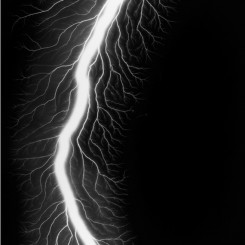Solo exhibition by Hiroshi Sugimoto.
Pace Beijing (798 Art District, No. 2 Jiuxianqiao Road, Chaoyang District, Beijing). May 12 to July 7, 2012.
Of all the exhibitions currently adorning the walls and atria of 798, Hiroshi Sugimoto’s solo at Pace has international “master artist” cachet. On show are excerpts from a number of his major series. All are gelatine silver prints born of what Sugimoto calls “the abandoned realm of analog silver” in a slightly immodest preface in which he also aligns his technically anachronistic processes and “infinite monochrome tonalities” with the influence of Song Dynasty masters.
But it is a lyrical introduction, too, wherein he remarks on the passing of old methods (“The tide has gone out on…silver halide photography”), consumed by the waves of the digital new, thus invoking a metaphor which summons nicely the final room of the exhibition, where hang the famous seascapes begun in 1980. A visual hymn of horizontal grey — sky and sea alone — these fast exposures reverberate simultaneously with the movements and mass of the ocean, preserved in a consummate shot. Their steadfastness hinges not only on Sugimoto’s perfectionism, but also on the status of the photograph as an incision into time. Here, one feels this is not of a contemporary instant — a moment taken — but a deep cut through innumerable layers into the unchanged field of the ocean — its depth now temporal, its waves unmeasured. Working backwards through the show, the movie theater series, for which the shutter remained open for the entire time lapse of a film, are striking again. Pristine, somehow sublime, these screens incandescent with the rush of images through them stand luminous in contrast with the dark architectural details and rows of seats attending them. There are messianic echoes, even, in these black boxes bleached out by their own messages.
Thus, there are subjects which seem perfectly suited to Sugimoto’s fascination with time and his highly finished approach — the sea, sky and screens, fields of water or light on a horizontal format. The rest of this exhibition consists of extracts from four other series: Lightening Fields, Dioramas, Conceptual Forms and Henry VIII and His Wives. The first of these, wherein the effects of electrical discharges are recorded, make for dramatic if ultimately unmoving works. The smooth forms, too, of instruments made to visualize mathematical concepts are astutely attractive, reminiscent of Edward Weston’s monochrome studies of shells and other natural objects. The other two series, however — products of Sugimoto’s interest in recreating or constructing “real” images — are arguably less easily liked. Whereas the Henry VIII… series might be interpreted with interest from an art historical point of view (for emulating lighting effects from 16th Century painting) and remembered for an eerie quality, the examples here from Sugimoto’s Dioramas — particularly that of early man and woman strolling through a sketchy landscape — are offputtingly bogus. Moving quickly past these, the exhibition develops through photographs of objects, theaters and oceans into something altogether more eminent.
